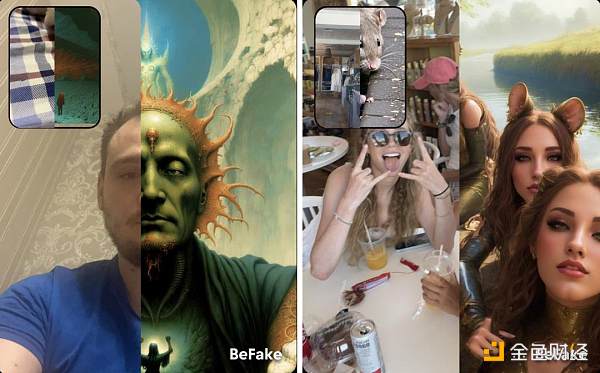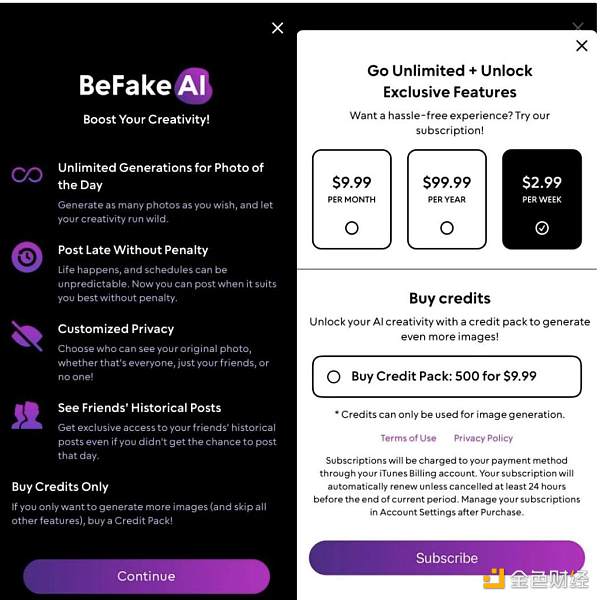The American version of ‘Miaoya’ becomes popular, defining new social interactions with ‘falseness
Miaoya', the American version, gains popularity, redefining social interactions with 'falseness'.Not long ago, the “Miao Ya Camera” App became popular, not only causing a big earthquake in the “photo-taking industry”, but also proving to people that besides chatbots, AI can also create various explosive products in the field of images.
In Europe and America at the same time, a selfie app related to AI also became popular. However, unlike Miao Ya’s “relatively real” route, this app called BeFake completely went in the opposite direction of AI selfies.
BeFake claims to be the “first AI-enhanced social network”, completely abandoning the “authenticity” of social media and using AI to push its “falseness” to the extreme.
This app encourages users to imagine freely and boldly use AI to transform everyday photos into fantasy scenes, and then share these “creative works” with others. Just like the definition given by its company, Alias Technologies, for this app: “a channel of expression, a new way for users to connect with friends through AI-generated visual effects.”
- The Strongest Encryption Declaration in History Permissionless, Declaring War on Traditional Financial Rules
- Beginning to target centralized crypto institutions? Lazarus’ five hacking attacks within 104 days
- LianGuaiWeb3.0 Daily | Hong Kong police are investigating whether JPEX is involved in criminal activities
Similar to the sudden popularity of “Miao Ya”, BeFake AI was launched on Google Play and the Apple Store in August, and has become extremely popular in just a few weeks, ranking high on the free charts of the App Store in the United States, the United Kingdom, and France.
At the same time, the team has received a $3 million investment from venture capital firms, and maintaining triple-digit growth has also given BeFake an advantage in the next round of financing talks.
In the current era where filters on Snap and TikTok have already been overused, why can an app that “creates falsehood” still excite young people and investors? What opportunities does BeFake’s success reveal?
01 AI “Enhancing Self”
BeFake uses black as the theme color of the app, and also adds a deep purple color that is the same as the icon, giving the app a touch of magic.

The app provides a user-friendly interface that displays various functions available for exploration, mainly three different information streams, including “friends”, “top defects”, and “discovery”.
After users complete phone number registration and account creation, they can start receiving notifications, interact with the BeFake community, freely add friends, and browse AI-generated images.
As for the core gameplay of the app, BeFake is similar to BeReal.
At a certain time each day, it will remind you to take a photo and activate both your front and rear cameras at the same time.

However, in BeFake, what you upload is not unedited original photos, but photos edited and published using AI. Moreover, from the moment the timer rings, you will have 20 minutes to complete the “upload”.

When editing photos, you can use BeFake’s existing style prompts and custom location prompts to create stunning and surreal images. For example, you can replace the background with world landmarks such as “Grand Canyon” or “Giza Pyramids” instead of sharing another photo taken in a bedroom.
In addition, you can also input custom text prompts, such as “Turn us into mouse spirits,” to explore the infinite possibilities of creating your own digital world.

Image source: GamesBeat
In fact, BeFake strives to make every moment magical and eliminate boring posts. Dumont, one of the co-founders of BeFake, once said, “BeFake can turn boring into exciting in five seconds.”
And its true fun lies in encouraging you to discover your own creativity and imagination to change and create your own images. As its slogan says: Since “fake” can be more interesting, why pursue “reality”?
And sometimes, “fantasy can better reflect reality.”
After all, although the photos are “fake,” the users are “real” ——they are you. When you take a photo, you can recognize it, and even after you transform it with AI, you can still recognize that it’s you. You can break through your own limitations, but its essence is still you.
Once you are satisfied with the photo, you can “upload” the AI-enhanced photo to the “friends” feed or the “discovery” feed, and you can also share it on other social media platforms.

If you have strong creativity and publicly post pictures on the “discovery” feed, you may accumulate a group of followers.
Scroll through the “top defects” image posts, and you will see Jokers, dragons, half-robots, ancient gods, and even strange Snoopy dogs.
In addition, users can compare the original photos with the AI-processed photos by swiping left and right.
Currently, BeFake is available on iOS and Android platforms.
Its basic functions are free, but premium users can access more features through subscriptions. For example, subscribed users can anonymously post their own photos, even without uploading personal updates. They can also view and rate others’ updates and provide other feedback.
In addition, subscription benefits include the ability to delay posting without being penalized, view friends’ past updates, and receive unlimited AI-generated prompts to create more cool images, and more.
Users can subscribe to BeFake on a weekly, monthly, or annual basis, with subscription fees of $2.99 per week, $9.99 per month, or $99.99 per year. In addition, users can also purchase points separately, with 500 points costing only $9.99.
The business model of BeFake is very clear here – subscription payment.

In short, BeFake AI is essentially a social app with AI-generated images as its core gameplay. Its user-friendly interface ensures a seamless experience from “imagination” to “picture”. Users can join the BeFake community to authentically showcase themselves through “false” expressions and share their “creativity” with friends.
02 Gaming Experience Gives Birth to “Virtual” Social Interaction
BeFake is the first product of Alias Technologies, an AI software development company.
The company was founded in 2021 and specializes in the development of generative media and multimodal AI systems.
The founders of the company are Kristen Garcia Dumont and Tracy Lane, who previously served as the CEO and COO of the gaming giant Machine Zone. Dumont led the development and launch of two of the world’s most profitable mobile social games: “World War: Rising” and “Final Fantasy XV: A New Empire”, with total revenue exceeding $1 billion. Lane was responsible for community, management, compliance, and platform partnerships.

Kristen Garcia Dumont is the CEO of BeFake|BeFake
During their years in the gaming industry, they discovered that game players can establish deep connections and have good interactions on platforms even without using their real identities, thanks to platform algorithms.
This made them realize that “in fact, you can build an interpersonal network around common interests. For games, the common interest is the game. For social networks, the common interest can be the joy of creating truly creative AI works.”
Therefore, combining AI and computer vision with social networks and breaking the “barriers to interpersonal communication” through AI became their plan.
Subsequently, these two founders started the BeFake AI project, aiming to cultivate a “creative community” and encourage users to establish connections through creating imaginative AI content, thus pioneering new forms of interaction between humans and AI and achieving the “democratization” of social media.
Their bet at the time was that “people will interact more and more with robots. If we can be one of the first companies to introduce AI into the social environment, it will be very special because we have seen the spark of AI in games.” “But two years ago, generative AI hadn’t started to become popular, and we thought we were crazy.”
When asked why they named it “BeFake,” Dumont explained that “they tried to discard the entire concept of current social media: either you need to beautify yourself in post-production or plan yourself in advance.” “When people often feel anxious and vulnerable when publishing ‘real’ content, staying true to oneself is very tense, making social interaction difficult. Therefore, BeFake allows people to create AI fake images to enhance themselves.”
Currently, BeFake is still focused on generating interesting static images through AI and hopes to turn more content consumers into content creators by making complex technology easier to use, but it may enter the field of video in the future.
For BeFake, the future development of this social app depends on its platform “community,” according to founder Dumont.
She believes that “the moat of most AI applications lies not in the underlying technology, but in the community.“
“We all have proprietary technology, but only when the open-source community becomes larger and open-source tools become better, can you better utilize and improve these tools.” “And as a robot, BeFake AI can contribute content along with the content created by people themselves. Therefore, we attach great importance to building a community, and to do this, you must be able to respond quickly to the community.”

In fact, the company has been working towards this direction, and one of the methods is to understand what kind of AI images users like in order to improve its algorithm.
Moreover, as time goes on, BeFake’s operation will require more powerful computing power as support. Therefore, like other companies, BeFake needs to strike a balance between providing users with free AI generation functions and charging for the use of computing resources.
Not long ago, BeFake announced that it has received support from a $3 million seed fund led by Khosla Ventures. Other investors in this round of financing include Next Coast Ventures, Maveron Ventures, Peter Thiel, Joe Lonsdale, and WS Investments.
“BeFake is the antidote to over-curated social media, and it is also a medium for self-expression.” “As an AI prompt app, BeFake not only represents the growing presence of AI in our social circle, but also a revolution in the way we interact on social media,” said Dumont.
We will continue to update Blocking; if you have any questions or suggestions, please contact us!
Was this article helpful?
93 out of 132 found this helpful
Related articles
- My Perspective on Token2049 in Singapore
- Chain Game Weekly Google to Allow NFT Game Advertising Placement, Linea Launches Web3 Entertainment Festival
- The Future of Derivatives Trading Platforms
- ANZ Bank uses Chainlink CCIP to test the purchase of tokenized assets
- Is the encryption industry ready to welcome the influx of funds from Wall Street?
- US SEC Targets NFTs What Does It Mean for NFTs?
- Messari Farcaster’s usage rate has reached a historical high recently. What are the key factors driving Farcaster’s growth?






